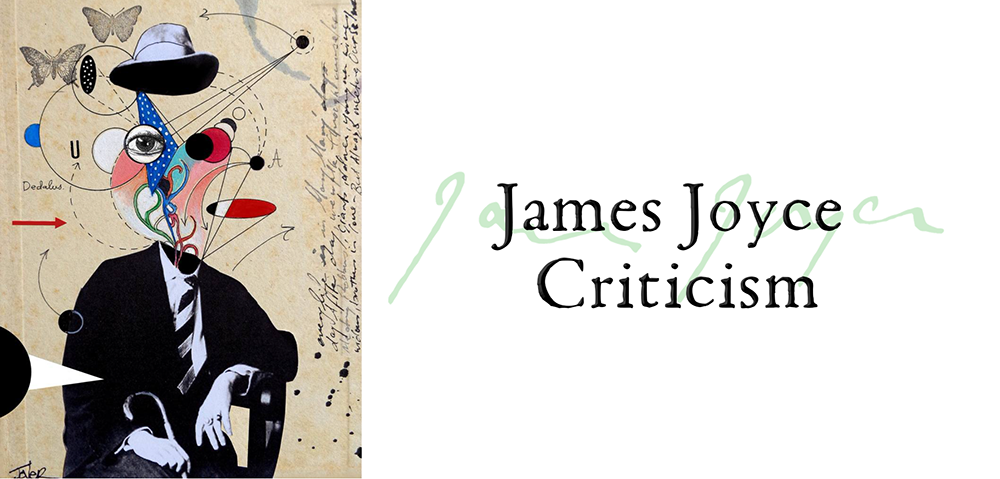Joyce Criticism: “Dubliners”
- At November 01, 2021
- By Great Quail
- In Joyce
 0
0
Joyce Criticism: Dubliners
This page profiles annotations, guides, and criticism related to Dubliners, James Joyce’s collection of short stories published in 1914. Annotated editions of the text are placed first, followed by criticism and guides listed in chronological order of publication. Clicking the image of a book takes you directly to Amazon.com.
Annotated Editions
Dubliners: Text, Criticism, and Notes (Viking Critical Library Edition)

Dubliners: Text, Criticism, and Notes (Viking Critical Library Edition)
By James Joyce. Edited by Robert Scholes & A. Walton Litz
First Edition: Viking, 1976
Revised edition: Penguin, 1996
Available online at: Internet Archive
Bob Williams: A good chronology and two useful maps are part of the front matter. The text of the stories is corrected by Robert Scholes. The second part of the book is called “The Author and His Work.” It contains two pages from manuscript copies of “A Painful Case,” a description of the revisions to “Eveline” and “The Boarding House,” and the entire early version of “The Sisters,” a short description of epiphanies and epicleti and letters that detail the agony that Joyce suffered in the process of getting Dubliners published. The third part contains critical essays by various writers, some of which are more useful than others. Of the eleven critical papers, six concern “The Dead.” Annotations to the stories are in the back. This is an ambitious and carefully considered project with so many merits that it would be churlish to find fault. My own copy shows those signs of wear that speak eloquently of constant use.
James Joyce’s Dubliners: An Illustrated Edition with Annotations
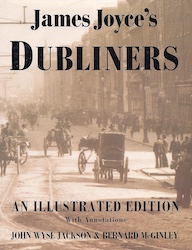
James Joyce’s Dubliners: An Illustrated Edition with Annotations
By James Joyce. Edited by John Wyse Jackson & Bernard McGinley
St. Martin’s Press, 1993
Available online at: Internet Archive
This impressive—and large!—book contains the complete Dubliners, along with hundreds of pictures, photos, sketches, newspaper articles, cartoons, annotations, handbills, letters, song sheets, and advertisements related to the text. It’s a staggering amount of material, a virtual re-creation of Edwardian Dublin in words and images. While a first-time reader is better served letting the stories speak for themselves free from distraction and clutter; for a Joyce enthusiast, this volume is the ultimate Dubliners experience.
Dubliners (Norton Critical Edition)
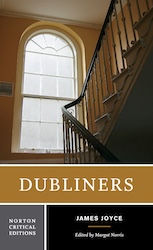
Dubliners (Norton Critical Edition)
By James Joyce. Edited by Margot Norris
W.W. Norton & Company, 2006
Available online at: Internet Archive
Publisher’s Description: Through what Joyce described as their “style of scrupulous meanness,” the stories present a direct, sometimes searing view of Dublin in the early twentieth century. The text of this Norton Critical Edition is based on renowned Joyce scholar Hans Walter Gabler’s edited text and includes his editorial notes and the introduction to his scholarly edition, which details and discusses Dubliners’ complicated publication history. “Contexts” offers a rich collection of materials that bring the stories and the Irish capital to life for twenty-first century readers, including photographs, newspaper articles and advertising, early versions of two of the stories, and a satirical poem by Joyce about his publication woes. “Criticism” brings together eight illuminating essays on the most frequently taught stories in Dubliners―“Araby,” “Eveline,” “After the Race,” “The Boarding House,” “Counterpoints,” “A Painful Case,” and “The Dead.” Contributors include David G. Wright, Heyward Ehrlich, Margot Norris, James Fairhall, Fritz Senn, Morris Beja, Roberta Jackson, and Vincent J. Cheng. 8 maps; 20 illustrations.
Criticism & Guides
Joyce* Annotated: Notes for Dubliners and A Portrait of the Artist as a Young Man
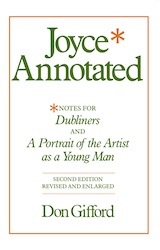
Joyce* Annotated: Notes for Dubliners and A Portrait of the Artist as a Young Man
By Don Gifford
First Edition: Dutton, 1967
Second Edition, Revised and Enlarged: University of California Press, 1982
Available online at: Internet Archive
In the world of Joyce annotations, Don Gifford has been a reliable guide for decades, and this work belongs on any Joycean’s shelf. Gifford begins with an introduction to Dublin at the turn of the century, including education, history, commerce, and social customs. The book goes on to provide thousands of annotations, including explanations of slang and foreign languages used, relevant song lyrics, literary references, historical notations, and places and institutions mentioned in the text. Maps are sprinkled throughout the book, and it ends with a reprinting of “The Sisters” by “Stephen Daedalus,” as it appeared in the Irish Homestead on August 13, 1904. Overall, a very thorough job that illuminates both works quite nicely!
James Joyce’s Dubliners (Harold Bloom’s Modern Critical Interpretations)
James Joyce’s Dubliners (Harold Bloom’s Modern Critical Interpretations)
Harold Bloom & William Golding, Editors
Chelsea House, 1988
Available online at: Internet Archive
Part of Harold Bloom’s “Modern Critical Interpretations” series, this book features eleven essays about Dubliners.
Publisher’s Description: According to Bloom, James Joyce’s Dubliners is a more aesthetically mixed work than much criticism of the author acknowledges. Bloom calls the collection of short stories “admirable and unified,” lauding “Ivy Day in the Committee Room” as a masterpiece. Many critics deem “The Dead” as the first piece to represent the mature Joyce. Also contains an introductory essay by Harold Bloom, critical biographies, notes on the contributing critics, a chronology of the author’s life, and an index.
Contents:
- Harold Bloom: Introduction
- Robert Adams Day, “Joyce’s Gnomons, Lenehan, and the Persistence of an Image”
- Tilly Eggers, “What Is a Woman…A Symbol Of?”
- Phillip Herring, “Structure and Meaning in Joyce’s ‘The Sisters’”
- Mary T. Reynolds, “The Dantean Design of Joyce’s Dubliners”
- Hugh Kenner, “Berlitz Days”
- John Paul Riquelme, “Metaphors of the Narration/Metaphors In the Narration: ‘Eveline’”
- Lindsey Tucker, “Duffy’s last Supper: Food, Language, and the Failure of Integrative Process in ‘A Painful Case’”
- Ross Chambers, “Gabriel Conroy Sings for His Supper, or Love Refused (‘The Dead’)”
- Fritz Senn, “‘The Boarding House’ Seen as a Tale of Misdirection”
- Thomas B. O’Grady, “‘Ivy Day in the Committee Room’: The Use and Abuse of Parnell”
- Margot Norris, “Narration Under a Blindfold: Reading Joyce’s ‘Clay’”
Suspicious Readings of Joyce’s Dubliners
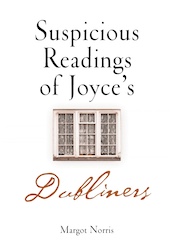
Suspicious Readings of Joyce’s Dubliners
By Margot Norris
University of Pennsylvania Press, 2003
Available online at: Internet Archive
Publisher’s Description: Because the stories in James Joyce’s Dubliners seem to function as models of fiction, they are able to stand in for fiction in general in their ability to make the operation of texts explicit and visible. Joyce’s stories do this by provoking skepticism in the face of their storytelling. Their narrative unreliabilities—produced by strange gaps, omitted scenes, and misleading narrative prompts—arouse suspicion and oblige the reader to distrust how and why the story is told. As a result, one is prompted to look into what is concealed, omitted, or left unspoken, a quest that often produces interpretations in conflict with what the narrative surface suggests about characters and events. Margot Norris’s strategy in her analysis of the stories in Dubliners is to refuse to take the narrative voice for granted and to assume that every authorial decision to include or exclude, or to represent in a particular way, may be read as motivated. Suspicious Readings of Joyce’s Dubliners examines the text for counterindictions and draws on the social context of the writing in order to offer readings from diverse theoretical perspectives. [It] devotes a chapter to each of the fifteen stories and shows how each confronts the reader with an interpretive challenge and an intellectual adventure. Its readings reconceive the stories in wholly novel ways—ways that reveal Joyce’s writing to be even more brilliant, more exciting, and more seriously attuned to moral and political issues than we had thought.
Joyce Criticism
[Main Page | General Criticism | Dubliners | Portrait | Ulysses | Finnegans Wake]
Authors: Allen B. Ruch & Bob Williams
Artwork: Loui Jover
Last Modified: 13 June 2024
Main Joyce Page: The Brazen Head
Contact: quail(at)shipwrecklibrary(dot)com

